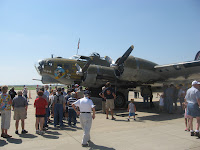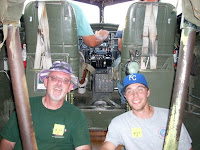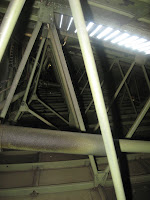Notes from the Road, Part 3, July 9, 2009, 1600-2350.
We were all enjoying looking over the bridesmaid when the bride showed up about 1600. The old 24 suddenly became a nice place to stand in the shade while we watched the Boeing B-17 Flying Fortress land and taxi up to the static display area. She had everyone’s attention. Even though the 24 flew higher, longer, and carried a bigger payload, the 17 always has been the darling of the show and one can see why. Where the 24 waddles, bobs and weaves as it taxis, the 17 is a graceful lady and there is also no comparison when in flight. It’s no wonder folks have flocked to her in droves. One can even tell it by the number of folks who paid to fly on her these few days. The 24 had two flights this evening; the 17 had three. And tomorrow the 24 wouldn’t leave the ground except to fly to KC while the 17 garnered 4 more flights.

Anyway the 17 came to a stop west the 24. We had to hold back the crowds as they rubbernecked trying to get just that right photo. Brad, by the strength of his personality, held them all back himself while the rest of us went to the bomb bay to get the cones and string out the rope around the plane. The cones were held, six at a time by a piece of threaded rod and hooks, to the inside of each bomb bay door. It seemed so strange to see the 17 sitting there in its tail down position. Whereas the 24 has a tricycle landing gear arrangement (one under each wing and one at the nose) so it sits fairly level when parked, the 17 is a “tail-dragger” with a wheel under each wing and a tail wheel, the failure of which caused its delay from Pueblo, Colorado today. The tour for the 17 started with a ladder up into the crew access door in the front port side (remember Gregory Peck in “12 O’clock High”?) where one would normally reach up and grasp the frame like a pull up bar and swing one’s legs up and in. The queue was about 50 people long by now and they began to be able to go into the plane.

For this particular tour, they went in via the aforementioned hatch which brings one in under the flight deck and gives one a view to your left of the nose arrangement: bombardier and navigator positions. You then moved to your right through the radio operator/flight engineer/upper turret gunner “room”. I say “room” as I noticed while the 24 was laid out in such a way one always was watching out for head banger and shin knockers and always climbing over and around things. While it is true the 17 also had plenty of tight spots, it appeared to have had more thought put into simple things that made it easier to get around and more comfortable for the crew. This area even had a hatch, about four foot by three foot in the upper fuselage forward of the upper turret that could be taken out and left open even in flight. More about that later. Anyway, then one went on the catwalk through the bomb bay and into the next “room” which contained the lower ball turret housing and waist gunner positions. On the starboard side was an exit door much more like a passenger airliner. From there, they had up a canvas bulkhead and no one was able to go back into the tail gunner position. I understand it’s accessed by a small tunnel and would be difficult for tourists to get in and out of without holding up the show.
I tell you all about this tour however I never got inside the plane until the moment I got in the rear door to go on the flight. More about that later. At this time I was busy watching the crowd and Brad and I got back to our grease wiping duties. The pilot (sorry I never caught his name as he was always gracious and kind, never forgetting to thank us grease monkeys for taking care of his plane) started wiping her down too and before long I had an oil-soaked rag. I’ve noticed the engines on these planes lose a lot of oil, not surprisingly, since they’re almost 70 years old. Oh I know, they have certainly been rebuilt but I think the initial Pratt and Whitney models were that way too. I assume (from no experience of course) that they were made to be loose to a certain degree to prevent wear and it was natural to go through some oil. I found out the 17 uses 200 gallons of fuel/hour and a gallon of oil. In each wing, aft of the interior engines (#’s 2 and 3), up in the wheel storage area, is an oil tank of about 35 gallons for the engine’s use.
We wiped down the plane and I asked the Captain what else I could do for his plane and he said I could get the ladder and wipe down the engine casings (the big casing that you see at the front of the engine with all the lines going into it containing the crank and out of which the pistons project). He said “Number Four’s kind of juicy”. I got out the ladder, careful not to bang it against the props and cleaned each one, including the rubber and chrome lines. I started with number one and worked my way to the starboard. I found out that number three had a black hub where the others were chrome. And I got to number four and it WAS a bit juicy.
We finished up and I spent a little time by the ladder, chatting up folks. A couple of big old farm boys (men, actually) came up and were excited about looking inside. Both of them had not missed many meals around the dinner table but the larger of the two appeared to be about 6’6 or so and I’d say 300 pounds. When they went in, I stepped over to the bomb bay. At that point you were about four feet below the cat walk and you should have heard the caterwallin’ as they made their way to the bomb bay and then tried to skinny through it. Both of the planes not only have the catwalk, about 10” wide to walk on, but uprights at a couple of places going up to the top that supported the catwalk and on which the bombs hung. They angled as they went up so started at 10” at the catwalk and got wider on the way up but apparently not wide enough for these boys. It took a bit of exertion to get through there but they were determined and eventually made it. It was fun to watch.

I didn’t get to talk to many veterans but did chat with one fella and his wife as they looked on and I stood around the number four engine. A lot of questions started out “Hey, I’ve got a question for you” and this one was no different. He wanted to know who manned all the guns in the front since there were three (two cheek guns, one on each side, and a dual chin gun). I pondered a bit and allowed how I wasn’t sure either. As far as I knew, there was only two in the front: the navigator and the bombardier. I said I’d have to find out. I went back in and talked to Rick (I think) and he said it was simple, the bombardier had a horseshoe type sight and controls in front of him which ran the chin guns and the navigator alternated between cheek guns as the need showed itself. Makes sense to me. While I was up there I ran into Brad. He had two bright green stickers in his hand much like I had seen many lucky stiffs wearing that were to take the flights. Lo, and behold, we got on the number 3 flight and I was going to get the chance of a lifetime, riding the B-17! I had hoped I would get that chance but honestly had told Steve it was a thrill for me just to be able to be around the planes on the ground and they didn’t have to feel like they had to give me a ride. But I wasn’t turning it down!
I went back out to find my friend who asked the question and eventually found him in the shortening line to tour the plane. I dutifully gave him the answer he wanted then got out of the way as the last of the crowd got their turns. Eventually, everyone was brought back into the holding area just outside the hangar and the planes were readied for their flights. The first groups got a briefing with the pilots outside each plane and then were loaded up for the flights. They were half hour flights and when the planes would land, they’d taxi over, let one group out, and the other would load up. Our safety briefing was held in the air conditioning by Fred and you could tell he had done it once or twice. He added a bit of humor telling us if you got sick there were sick sacks in each first aid kit and to please use them. When done, hang onto it and take it with you. And be aware, airsickness is contagious; when one does it, invariably someone else will follow. I understand on one flight a fella got sick and just puked inside his shirt. Wasn’t me-I was wearing my good B-24 shirt and wouldn’t do that to it.


The first two flights of each plane went up and then we were called out to stand by to board the plane. It would be coming in such that the rear door would be facing us. Rick said for Brad and I to get to the front and run to the door where Steve would meet us and sit us up by the pilots. I think we were getting preferential treatment for sure. Steve was the Flight Engineer/Stewardess on the 17 flights and did a good job. When it landed, we hot-footed it for the door where Steve was standing. I felt kind of rude, going to the front like that but orders were orders. Steve shooed us through the bomb bay and sat us in the radio operator/flight engineer takeoff positions which were on the floor with our backs to the pilot and copilot’s seats. The seat belts were original and nothing fancy. I thought I was a reasonably intelligent fella but after a few tsk-tsks by Steve he showed us how to buckle them up. It didn’t take long and the engines came up to speed. As we taxied, Steve took up his position standing in the upper turret and looking out for obstructions, etc. I got a great view of his hairy legs all the way up to his suntanned head peering out the plexiglass. Then, off into the wild blue yonder over Salina. Steve gave us the “unbuckle the seatbelt” signal and the tour began.

We were told there were two rules: don’t bother the pilots and don’t fall out of the plane, both of which I intended to follow. But other than that, we were free to go anywhere but the tail gun position just being courteous of others who wanted to see the same things. Brad and I wanted to see the nose first since we were the closest to it anyway, so we dropped into the hell hole (the crawlway from under the flight deck to the nose) and got to spend quite a bit of time taking pictures and rubbernecking out the windows. There was even a plexiglass bubble forward of the pilots and above the navigator’s position where you could look back at them and take a picture. We bombed some imaginary targets and shot down some imaginary German fighters then back through the hell hole to the RO/FE position. That hatch I spoke of earlier was open to the sky and we were free to stick out our heads, or anything else we weren’t afraid of losing, into the slipstream. I took off my hat and was careful with my glasses. It was amazing-a big giant hole in the top. Made for some good ventilation throughout also. It was here that Steve showed me a couple of holes in the fuselage that looked out into the interior of the wing. I told him my granddad was a small man and one of his jobs at the Boeing factory was to work in the wings.

We moved on back through the bomb bay where Steve showed us the manual crank positions for the wheels and bomb bay in case they wouldn’t open. Then on to the waist gunners positions and got a chance to shoot down some more imaginary planes and strafe some unsuspecting cows (Oh, George, not the livestock!). Way too soon, Steve gave us the “buckle up” sign and we scurried back to our positions. Landing was a bit of a “bounce-a-roo” and then we taxied and rolled to a stop back at the hangar. Steve disappeared and out the forward crew “Gregory Peck” hatch. Steve said we could come out this way too if we wanted. We wanted! He said to just not fall out as it was a good drop. We got to swing out just like the real boys did and drop to the ground. Hard on my old body but I didn’t let on and would have gone around for another go if they’d let me.
By now the excitement was beginning to wane and it was getting late. The adrenaline was bleeding off I suddenly realized I was REALLY tired and REALLY sun and wind burned. The crowd left and Steve, Brad, and I loaded into the Blue Goose to head to the Hickory Hut for some more BBQ. As we pulled in we realized the little restaurant was only open inside until 2030 and it was now 2050. Drive up closed at 2100. YIKES! We pulled around and ordered, got our goodies (except for Brad’s Mountain Dew) and drove to the Quality Inn where we enjoyed our repast on the tables in the atrium of the Quality Inn. I have GERD (Reflux) and it’s not good for me to eat so late. Also, I hadn’t had any carbonation for about three years but got a root beer with my meal. At this point, I didn’t care. I had flown in a B-17! I could die now and no big deal so I lived life on the edge and ate BBQ. Surprisingly, it was excellent, especially the burnt ends.
We toddled off to our rooms where the pup promptly turned on Sports Center for noise and crawled under the covers. I stayed up until almost midnight sorting and uploading pictures to Facebook but there just wasn’t enough time in the day to do these notes also. Besides I’d have time to write later. What more excitement could there be after this great day? Well, just when you think the Lord has showered you with all the blessings you can stand, He says “hide and watch what’s next”.


